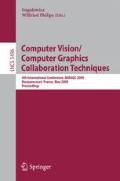Abstract
Structured light techniques with binary coding are practical to inspect the specular surfaces. The structured light approaches use a scanned array of point sources and images of the resulting reflected highlights to compute local surface orientation. Binary coding scheme is the classic scheme for efficiently coding the light sources. This paper proposes a novel quaternary coding scheme which is much more efficient than the classic binary coding scheme. In this scheme, polychromatic light sources are utilized and coded in quaternary scheme. Our experimental system is described in detail. The problem caused by the polychromatic light sources is discussed too. To solve the problem, we drew lesson from the erosion operator from the Mathematical Morphology and designed an effective algorithm. The experiment results show the new quaternary coding scheme not only keeps a very high accuracy, but also greatly improves the efficiency of the inspection of specular surface.
Access this chapter
Tax calculation will be finalised at checkout
Purchases are for personal use only
Preview
Unable to display preview. Download preview PDF.
References
Blake, A., Brelstaff, G.: Geometry from specularities. In: Second International Conference on Computer Vision, pp. 394–403 (1988)
Zisserman, A., Giblin, P., Blake, A.: The information available to a moving observer from specularities. Image and Vision Computing 7(1), 38–42 (1989)
Schultz, H.: Retrieving shape information from multiple images of a specular surface. IEEE Transactions on Pattern Analysis and Machine Intelligence 16(2), 195–201 (1994)
Bonfort, T., Sturm, P.: Voxel carving for specular surfaces. In: Int. Conf. Computer Vision, Nice, France, pp. 591–596 (2003)
Yang, R., Pollefeys, M., Welch, G.: Dealing with textureless regions and specular highlights—a progressive space carving scheme using a novel photo-consistency measure. In: Int. Conf. Computer Vision, Nice, France, pp. 576–584 (2003)
Solem, J.E., Aanæs, H., Heyden, A.: Pde based shape from specularities. In: Griffin, L.D., Lillholm, M. (eds.) Scale-Space 2003. LNCS, vol. 2695. Springer, Heidelberg (2003)
Solem, J.E., Aanæs, H., Heyden, A.: A variational analysis of shape from specularities using sparse data 3D Data Processing, Visualization and Transmission. In: Proceedings of 2nd International Symposium on 3DPVT 2004, September 6-9, pp. 26–33 (2004)
Jalkio, J.A., Kim, R.C., Case, S.K.: Three dimensional inspection using multistripe structured light. Opt. Eng. 24(6), 966–974 (1985)
Wahl, F.: A coded light approach for depth map acquisition,Muskererkennung 86, Informatik Fachberichte 125. Springer, Heidelberg (1986)
Sanderson, A.C., Weiss, L.E., Nayar, S.K.: Structured Highlight Inspection of Specular Surfaces. IEEE Transactions On Pattern Analysis And Machine Intelligence 10(1), 44–55 (1988)
Nayar, S.K., Sanderson, A.C., Weiss, L.E., et al.: Specular surface inspection using structured highlight and Gaussian images. IEEE Transactions On Pattern Analysis And Machine Intelligence 10(1), 208–218 (1990)
Wisniewski, A.: Digital control methods of LED and LED lamps. Przeglad elektro-techniczny 84(8), 178–181 (2008)
Gilewski, M., Karpiuk, A.: An electronic control of light RGB LEDs. Przeglad elektrotechniczny 84(8), 194–198 (2008)
Muller, C.D.: Reckefuss, Multi-color polymeric OLEDs by solution processing. In: Organic light-emitting materials and devices VII, vol. 5214, pp. 21–30 (2004)
Allan, G.R.: High-speed, high-resolution, color CCD image sensor. In: Proceedings of the society of photo-optical instrumentation engineers (SPIE), vol. 3965, pp. 70–79 (2000)
Debevec, P.: Image-Based Lighting. IEEE Computer Graphics and Applications 22(2), 26–34 (2002)
Soille, P.: Morphological Image Analysis: Principles and Applications, 2nd edn. (2003) ISBN:3540429883
Author information
Authors and Affiliations
Editor information
Editors and Affiliations
Rights and permissions
Copyright information
© 2009 Springer-Verlag Berlin Heidelberg
About this paper
Cite this paper
Xue, C., Sun, Y. (2009). An Improved Structured Light Inspection of Specular Surfaces Based on Quaternary Coding. In: Gagalowicz, A., Philips, W. (eds) Computer Vision/Computer Graphics CollaborationTechniques. MIRAGE 2009. Lecture Notes in Computer Science, vol 5496. Springer, Berlin, Heidelberg. https://doi.org/10.1007/978-3-642-01811-4_12
Download citation
DOI: https://doi.org/10.1007/978-3-642-01811-4_12
Publisher Name: Springer, Berlin, Heidelberg
Print ISBN: 978-3-642-01810-7
Online ISBN: 978-3-642-01811-4
eBook Packages: Computer ScienceComputer Science (R0)

